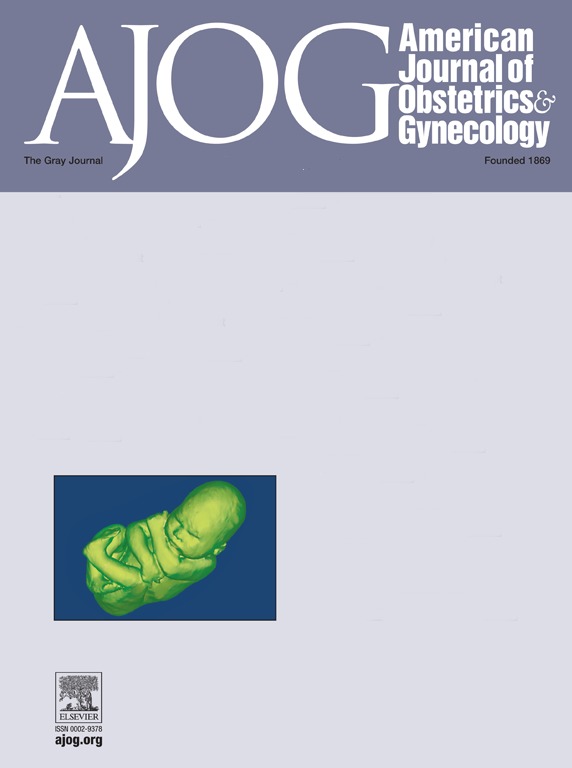Treatment of Traumatic Birth Experience with Postpartum Early Eye Movement Desensitization and Reprocessing Therapy: A Randomized Clinical Trial.
IF 8.4
1区 医学
Q1 OBSTETRICS & GYNECOLOGY
引用次数: 0
Abstract
BACKGROUND A traumatic birth experience can have negative consequences for both mother and infant, including developing (symptoms of) posttraumatic stress disorder, postpartum depression, difficulties in mother-infant bonding, fear of childbirth, or reduced quality of life. OBJECTIVES This study aimed to investigate the effectiveness and safety of early trauma-focused therapy, specifically eye movement desensitization and reprocessing therapy, in reducing symptoms and incidence of posttraumatic stress disorder at nine weeks postpartum in women with a traumatic birth experience, compared with care as usual (controls). STUDY DESIGN A randomized controlled trial was conducted in a hospital and 25 midwifery practices in Amsterdam, the Netherlands, enrolling women within fourteen days postpartum who reported a traumatic birth experience. The participants received two eye movement desensitization and reprocessing therapy sessions of 60 min per session (treatment group) or two telephone calls (controls) between two and five weeks postpartum. The primary outcome was symptoms of posttraumatic stress disorder at nine weeks postpartum measured by the self-report questionnaire PTSD Checklist for DSM-5 (PCL-5, cutoff ≥29 indicative of posttraumatic stress disorder) and the Clinician-Administered PTSD Scale for DSM-5 (CAPS-5), a structured interview. Secondary outcomes included symptoms of depression, mother-infant bonding, fear of childbirth, quality of life, and breastfeeding rates. RESULTS Of 10,963 women screened, 861 reported a traumatic birth experience and 151 participants were randomly assigned (1:1) to the treatment group (n=76) or control group (n=75). After randomization, seven participants withdrew informed consent and one participant was inaccessible leaving 74 participants in the treatment group and 69 in the control group for intention-to-treat analyses. The treatment group showed a larger reduction in PCL-5 scores than the control group (adjusted mean difference on square root scale =-0.82, 95% CI -1.24 to -4.04; P <0.001, mean difference =-8.7 points). Square root transformed CAPS-5 symptom severity scores were significantly lower in the treatment group (adjusted mean difference=-0.73, 95% CI -1.23 to -0.23, P =0.004, mean difference =-3.8 points). The incidence of probable posttraumatic stress disorder decreased more in the treatment group (39.2% (n=29) to 11.1% (n=8)) than in controls (44.9% (n=31) to 29.2% (n=19)); adjusted odds ratio=0.32, 95% CI 0.14 to 0.73; P =0.006. However, posttraumatic stress disorder diagnosis rates per CAPS-5 were not significantly different between groups: three participants (4.2%) in the treatment group versus six participants (9.1%) in the control group, P =0.310. Eye movement desensitization and reprocessing therapy reduced depressive symptoms (P <0.001), symptoms of mother-infant bonding difficulties (P =0.008), fear of childbirth (P =0.001), and quality of life in the psychological domain (P =0.006). No differences in breastfeeding rates were observed. Serious adverse events were not observed. CONCLUSION Compared to controls, eye movement desensitization and reprocessing therapy proved both effective and safe in reducing symptoms of posttraumatic stress disorder and related psychological distress in postpartum women with a traumatic birth experience. Its integration into postnatal care protocols may be of great benefit to this group.产后早期眼动脱敏和再加工疗法治疗创伤性分娩:一项随机临床试验。
背景:创伤性分娩经历对母亲和婴儿都有负面影响,包括出现创伤后应激障碍(症状)、产后抑郁、母婴关系困难、害怕分娩或生活质量下降。目的:本研究旨在探讨早期创伤聚焦治疗的有效性和安全性,特别是眼动脱敏和再加工治疗,在减少产后9周创伤性分娩经历的妇女的创伤后应激障碍症状和发病率方面,与常规护理(对照组)相比。研究设计:在荷兰阿姆斯特丹的一家医院和25家助产诊所进行了一项随机对照试验,招募了产后14天内报告分娩创伤经历的妇女。参与者在产后两到五周内接受两次眼动脱敏和再加工治疗,每次60分钟(治疗组)或两次电话治疗(对照组)。主要结局是产后9周的创伤后应激障碍症状,通过DSM-5 PTSD自我报告问卷(PCL-5,截止值≥29表示创伤后应激障碍)和DSM-5临床医生管理的PTSD量表(CAPS-5)进行结构化访谈。次要结局包括抑郁症状、母婴关系、分娩恐惧、生活质量和母乳喂养率。结果在10,963名接受筛查的妇女中,861名报告了分娩创伤经历,151名参与者被随机分为治疗组(n=76)和对照组(n=75)。随机化后,7名受试者撤回知情同意,1名受试者无法访问,剩下74名受试者为治疗组,69名受试者为对照组进行意向治疗分析。治疗组的PCL-5评分比对照组下降幅度更大(平方根标度校正平均差=-0.82,95% CI -1.24 ~ -4.04;P <0.001,平均差值=-8.7分)。治疗组经平方根变换后的CAPS-5症状严重程度评分显著低于对照组(调整后平均差异=-0.73,95% CI = -1.23 ~ -0.23, P =0.004,平均差异=-3.8分)。治疗组创伤后应激障碍发生率从39.2% (n=29)降至11.1% (n=8),高于对照组(44.9% (n=31)降至29.2% (n=19));校正优势比=0.32,95% CI 0.14 ~ 0.73;P = 0.006。然而,创伤后应激障碍诊断率在cap -5组之间没有显著差异:治疗组有3名参与者(4.2%),对照组有6名参与者(9.1%),P =0.310。眼动脱敏和再加工治疗减少了抑郁症状(P <0.001)、母婴结合困难症状(P =0.008)、分娩恐惧(P =0.001)和心理领域的生活质量(P =0.006)。没有观察到母乳喂养率的差异。未观察到严重的不良事件。结论与对照组相比,眼动脱敏和再加工治疗可有效、安全地减轻产后创伤后应激障碍症状及相关心理困扰。将其纳入产后护理协议可能对这一群体大有裨益。
本文章由计算机程序翻译,如有差异,请以英文原文为准。
求助全文
约1分钟内获得全文
求助全文
来源期刊
CiteScore
15.90
自引率
7.10%
发文量
2237
审稿时长
47 days
期刊介绍:
The American Journal of Obstetrics and Gynecology, known as "The Gray Journal," covers the entire spectrum of Obstetrics and Gynecology. It aims to publish original research (clinical and translational), reviews, opinions, video clips, podcasts, and interviews that contribute to understanding health and disease and have the potential to impact the practice of women's healthcare.
Focus Areas:
Diagnosis, Treatment, Prediction, and Prevention: The journal focuses on research related to the diagnosis, treatment, prediction, and prevention of obstetrical and gynecological disorders.
Biology of Reproduction: AJOG publishes work on the biology of reproduction, including studies on reproductive physiology and mechanisms of obstetrical and gynecological diseases.
Content Types:
Original Research: Clinical and translational research articles.
Reviews: Comprehensive reviews providing insights into various aspects of obstetrics and gynecology.
Opinions: Perspectives and opinions on important topics in the field.
Multimedia Content: Video clips, podcasts, and interviews.
Peer Review Process:
All submissions undergo a rigorous peer review process to ensure quality and relevance to the field of obstetrics and gynecology.

 求助内容:
求助内容: 应助结果提醒方式:
应助结果提醒方式:


